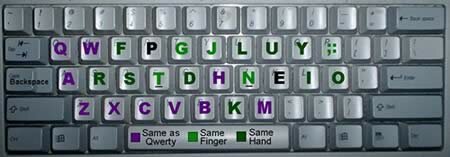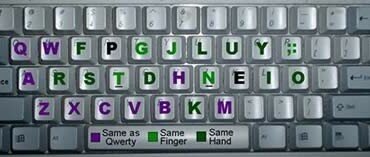Benefits Of Learning Colemak Keyboard Layout
For someone who has spent their entire life typing on a standard QWERTY keyboard, the idea of switching to a new format can be a bit intimidating. Many people don’t even know that there are multiple keyboard formats available. Even for those that do know, some formats are more popular than others. Below, we will discuss some pros and cons of the third most popular format, the Colemak.

Pros of learning Colemak layout
- Easy to learn. The Colemak format is going to offer the easiest transition for someone who has spent years typing on a QWERTY keyboard. Unlike the somewhat more complicated Dvorak format, the Colemak only switches two letters between hands and the letters that do move usually remain within a key or two of their original QWERTY location.
- Less Finger Movement. The QWERTY keyboard was designed with a machine in mind rather than a typist. Original typewriters used arms for each individual letter, and grouping letters that were commonly used together caused the arms to stick and jam. The Colemak format is designed the opposite. It reduces finger movement by 2.2 times.
- Eliminate repetitive stress injuries. Many people who type for a living complain of repetitive stress injuries in their fingers, wrists and arms. This is reduced by allowing the typist to type at speeds comparable or faster than their QWERTY keyboard without the excessive finger movement. This is ideal for anyone who spends their days with their fingers on a keyboard.
- Part Time Practice. Unlike the Dvorak format, Coleman’s similarity to the QWERTY format allows you to use the standard keyboard for everyday tasks and still practice the Colemak format in your spare time. Some of the other formats, such as Dvorak, are so far removed from the QWERTY format that when you choose to switch, it’s all or nothing.
- Accessibility. The Colemak format is available on both Android and iOS mobile devices. It is available through Google Play for Android devices, and online for iOS devices, though it does require a jailbroken phone. This is a great tool if you want to work on your key memorization, since most people look at their on screen keyboards when they type or text on their mobile devices.
- Shortcuts. Many people constantly use keyboard short cuts. Even you, dear reader, has probably used Ctrl-C to copy and Ctrl-V to paste. In other keyboard formats, the main shortcut keys are moved so dramatically that they are not feasible for use anymore. With Colemak, the main shortcut keys (Z, X, C, V, etc) remain in the same locations.
- An extra backspace. If reaching up to hit the backspace key after a mistake is a chore, this may be the format for you. Colemak remaps the Caps Lock key as an extra backspace key. It’s easily reachable by the left pinky, and it lowers errors that occur from having to remove your left hand from the home row to be able to strike the regular backspace.
Cons of learning the Colemak keyboard layout
- Learning Curve. If you type for a living, switching to a new keyboard format can put a damper on your work. You may, as a QWERTY typist, type 80 words per minute or faster (find out how fast do you type at http://www.ratatype.com/typing-test/). Switching to a new keyboard format, even one as similar as Colemak, is going to slow that by half or more while you’re learning.
- Not the fastest alternate format. If you’re looking for high typing speeds, Colemak may not be the best option. Using this format is as fast as or faster than QWERTY, but by switching to Dvorak you could possibly reach speeds of 150 words per minute or higher.
- Hardware. If you walk into a computer store, even one that specializes in technology, you are not going to find a Colemak keyboard. That’s because, at this point, they don’t exist. You can make your own, either by rearranging the keys on a keyboard or printing stickers to stick to the existing keys. Keep in mind; this is going to confuse anyone else who sits down at your machine.
- Software. Computers come preprogrammed for certain keyboard formats. QWERTY, the standard is the default setting on almost all computers. Many computers even have a setting for the Dvorak format. This is not the case for Colemak. The required software is available for free from www.colemak.com, however.
When it comes to the Colemak format, the pros outweigh the cons. It may not be something that a casual computer user would consider, but anyone who types for a living, or who is at risk for repetitive stress injuries from computer use, should look into it.
Adam Fort is educator and touch typing enthusiast. His goal is to help kids around the world to learn 21th century skills.








